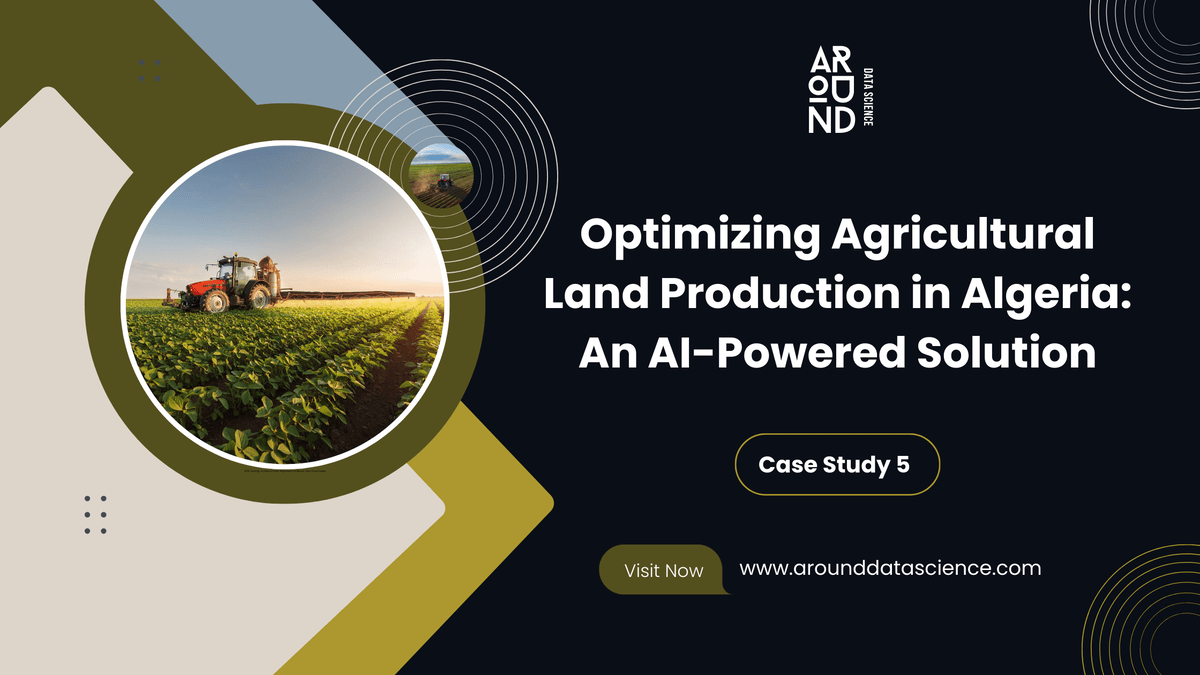Optimizing Agricultural Land Production in Algeria
Optimizing agricultural land production in Algeria is a critical challenge for ensuring economic stability and food security. Maximizing land productivity is essential, and AI-driven solutions offer promising advancements. This blog explores an innovative project developed by a team from the National Higher School of Artificial Intelligence, leveraging advanced search algorithms and a robust methodology to transform agricultural land production planning.
Team member’s contacts: Lyes HADJAR
Project Overview
The project focuses on optimizing agricultural land use in Algeria. It addresses key objectives such as maximizing crop production, achieving self-sufficiency, and minimizing consumer costs. By leveraging seasonal data, informed decision-making, and advanced algorithms, the solution offers a comprehensive plan for year-round agricultural productivity.
Objectives
- Maximize agricultural production across Algeria.
- Ensure self-sufficiency for essential crops.
- Minimize consumer prices while optimizing resource allocation.

Methodology
Data Collection and Processing
The project sourced data primarily from national agricultural records, ensuring relevance to the Algerian market. The data was divided into two CSV files:
- Wilaya.csv: Included data on Algerian provinces, free land, allocated land, and production metrics.
- Product.csv: Contained crop-specific data like prices, seasonal availability, and strategic importance.
Key Steps:
- Data Gathering: Divided among team members, enabling efficient coverage of all provinces.
- Data Cleaning: Ensured consistency and relevance by focusing on strategic crops and recent datasets.
- Data Structuring: Organized into well-defined CSV files for streamlined processing and analysis.
AI and Search Algorithms
A combination of search algorithms was employed to ensure efficiency and optimality:
- Uninformed Algorithms: Iterative Deepening Depth-First Search (IDS) and Uniform Cost Search (UCS) were selected for their low memory usage and cost-efficiency.
- Informed Algorithms: Iterative Deepening A* (IDA*) provided a balance between memory efficiency and optimality.
- Local Search: Hill Climbing with Steepest Ascent maximized production by iteratively improving solutions.
Comparisons of Search Algorithms
- IDA*: Delivered the fastest results with a runtime of 40.5 seconds and generated 1,021 nodes, making it the most efficient method.
- IDS: Took 130.8 seconds and generated 1,802 nodes, demonstrating higher resource usage.
- Uniform Cost Search: Required over two hours, illustrating its inefficiency for large-scale problems.
- Hill Climbing: Excelled in space efficiency but struggled with time complexity and local optima challenges.
The team’s decision to employ multiple algorithms allowed for a comparative analysis, ensuring the final solution leveraged the strengths of each method.
Explore : Create Your First Prediction Model: House Prices Project for Beginners – Around Data Science
Challenges Encountered
Key challenges included:
- Data Availability: Limited access to recent and comprehensive datasets required creative sourcing and assumptions.
- Computational Constraints: The large search space and high branching factor necessitated algorithm adjustments and testing.
- Seasonal Variability: Adapting the model to reflect seasonal differences required integrating domain knowledge with algorithmic design.
Solutions:
- Dividing tasks and leveraging collaborative problem-solving.
- Iteratively refining heuristic functions and cost models.
- Testing algorithms under varying conditions to ensure robustness.
Results and Impact
Performance Benchmarks
- IDA*: The fastest and most resource-efficient algorithm with a runtime of 40.5 seconds and memory usage capped at 1,021 nodes.
- IDS: Took 130.8 seconds and consumed 1,802 nodes in memory.
- Uniform Cost Search: Required over 2 hours, processing more than 100,000 nodes, which proved impractical for large-scale implementation.
- Hill Climbing: Achieved a runtime of 375.2 seconds but excelled in reducing memory usage to as low as 110 nodes.
Outcome Highlights
- Production Increase: Total production for all major crops increased by an average of 20% compared to baseline figures.
- Seasonal Planning: Developed a robust, season-specific agricultural plan aligned with Algeria’s unique agricultural cycles.
- Stakeholder Tools: Created a user-friendly GUI for visualizing and exporting results for policy-making and research.
Lessons Learned
- Heuristics: Designing problem-specific heuristics is crucial for algorithm efficiency and solution quality.
- Collaborative Innovation: Team brainstorming and iterative testing were pivotal in overcoming complex challenges.
- Scalability: The project demonstrates how AI techniques can scale to address national-level optimization problems.
See: Python Pandas Tutorial: A Complete Guide for Beginners – Around Data Science
Conclusion for Optimizing Agricultural Land Production in Algeria
This project showcases the transformative potential of AI in addressing agricultural challenges. By implementing sophisticated search algorithms and data-driven strategies, the team has created a scalable and impactful solution for Algeria’s agricultural sector. The comparative analysis of search algorithms provides a valuable reference for future applications, highlighting IDA* as a versatile and effective choice. This approach can serve as a model for similar initiatives worldwide.
What are your thoughts on leveraging AI for optimizing agricultural land production in Algeria? Share your experiences or insights in the comments. Explore more innovative case studies on our platform and join the conversation about AI’s role in sustainable development.
Ready to Dive Deeper?
🌟Feeling curious about where to go next? There are tons of online resources and beginner-friendly courses available to help you delve deeper into the world of Data Science. So, we encourage you to explore more content on Around Data Science.
Subscribe to our newsletter for regular updates and check out our first free eBook, AI for People in a Hurry: Inroduction to Artificial Intelligence. This comprehensive guide demystifies the world of AI and empowers you to leverage its potential in your everyday life, regardless of your role or background. Don’t miss out!
Welcome to a world where data reigns supreme, and together, we’ll unravel its intricate paths.




